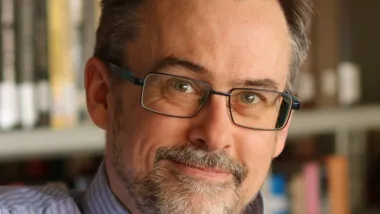In her new book, A Paradise Built in Hell: The Extraordinary Communities That Arise in Disaster, journalist and essayist Rebecca Solnit describes a phenomenon that is rarely mentioned in the context of disaster preparedness: the spirit of caring -- even joy -- that can emerge in the face of calamity.
In her new book, A Paradise Built in Hell: The Extraordinary Communities That Arise in Disaster, journalist and essayist Rebecca Solnit describes a phenomenon that is rarely mentioned in the context of disaster preparedness: the spirit of caring -- even joy -- that can emerge in the face of calamity.
In case after case, she finds that catastrophes tend to generate "disaster utopias," in which people spontaneously come to the aid of their neighbors, social and class distinctions are erased, and exciting social possibilities for a more just society are revealed.
By contrast, Solnit finds the Hollywood version of disaster -- replete with widespread panic, looting and violence -- is almost nonexistent in the real world, and where it does occur it is owed to institutional failure and repressive overreaction on the part of governments.
The San Franciscan's earlier works include the gentrification exposé Hollow City: The Siege of San Francisco and the Crisis of American Urbanism. Here she takes the reader through a number of historically significant disasters over the past century. Through archival research, numerous interviews with survivors and frequent references to disaster sociologists, Solnit constructs an alternative and radical narrative of calamity.
For each disaster covered (the 1906 San Francisco earthquake; the 1917 Halifax explosion; the 1985 Mexico City earthquake; 9/11; and hurricane Katrina), Solnit explores a series of themes, which she then connects to other disasters, social theories and contemporary events.
As a writer on the progressive left, Solnit has created a "people's history" of urban destruction, which shows how extraordinary acts of empowerment and social capacity-building can emerge from disaster, and with them the erasure of the caustic distinctions of class and race.
Solnit tells of the legendary generosity following the Halifax explosion, and how the failure of the Mexican government to respond to the 1985 earthquake there led to a nationwide political awakening, which eventually broke the decades-long grip on power of the PRI(Institutional Revolution) party.
She also recounts the heroic actions taken by the passengers of Flight 93 on 9/11, and contrasts them painfully with then-president George W. Bush's initial non-response to the attacks, and the Air Force's inexplicable inability to prevent the strike on the Pentagon.
Such institutional failure is compounded, in Solnit's view, by the tendency of governments and other elites to panic when calamity strikes.
By expecting the worst from people, governments can turn disasters into catastrophes. In 1906, the army was unleashed on San Francisco with shoot-to-kill orders and an incoherent plan to contain fires – an action which led to perhaps hundreds of deaths and the incineration of much of the city. The other major example she offers is how, fearing panic following 9/11, the Bush Administration encouraged New Yorkers to return far too early to the horrifically toxic air in Lower Manhattan.
By far the most disturbing part of Solnit's book is her extensive and ground-breaking investigation into the aftermath of hurricane Katrina.
Amid wild, racist and unfounded media rumours of black gangs rampaging through the streets of New Orleans and the Superdome, whites armed themselves and began shooting black men on sight. Solnit documents dozens of such murders, about which officials have yet to take action.
Yet even in the poisonous ruins of New Orleans, Solnit still manages to find irrepressible joy as people rebuild their homes.
This recurring spirit of common purpose and generosity leads to her principal and troubling question: what is it about our everyday society that prevents such social possibilities from taking root permanently?
Solnit's book raises important questions for planners concerned with disaster preparedness. As our cities become more vulnerable to extreme weather and climate change, Solnit warns we will face successive and intensifying disasters. Unless we combine practical training for dealing with calamity with an official recognition of our tendency for mutual support and aid, rather than for violence and looting, the "elite panic" she describes will lead to ever more terrible consequences.

Planetizen Federal Action Tracker
A weekly monitor of how Trump’s orders and actions are impacting planners and planning in America.

Chicago’s Ghost Rails
Just beneath the surface of the modern city lie the remnants of its expansive early 20th-century streetcar system.

Amtrak Cutting Jobs, Funding to High-Speed Rail
The agency plans to cut 10 percent of its workforce and has confirmed it will not fund new high-speed rail projects.

Ohio Forces Data Centers to Prepay for Power
Utilities are calling on states to hold data center operators responsible for new energy demands to prevent leaving consumers on the hook for their bills.

MARTA CEO Steps Down Amid Citizenship Concerns
MARTA’s board announced Thursday that its chief, who is from Canada, is resigning due to questions about his immigration status.

Silicon Valley ‘Bike Superhighway’ Awarded $14M State Grant
A Caltrans grant brings the 10-mile Central Bikeway project connecting Santa Clara and East San Jose closer to fruition.
Urban Design for Planners 1: Software Tools
This six-course series explores essential urban design concepts using open source software and equips planners with the tools they need to participate fully in the urban design process.
Planning for Universal Design
Learn the tools for implementing Universal Design in planning regulations.
Caltrans
City of Fort Worth
Mpact (founded as Rail~Volution)
City of Camden Redevelopment Agency
City of Astoria
City of Portland
City of Laramie






























